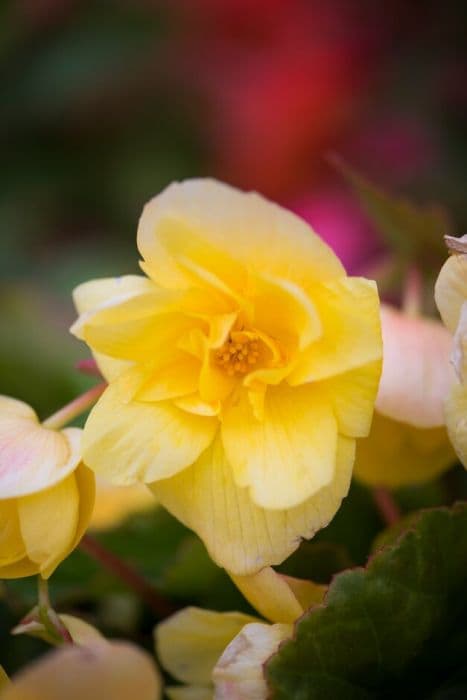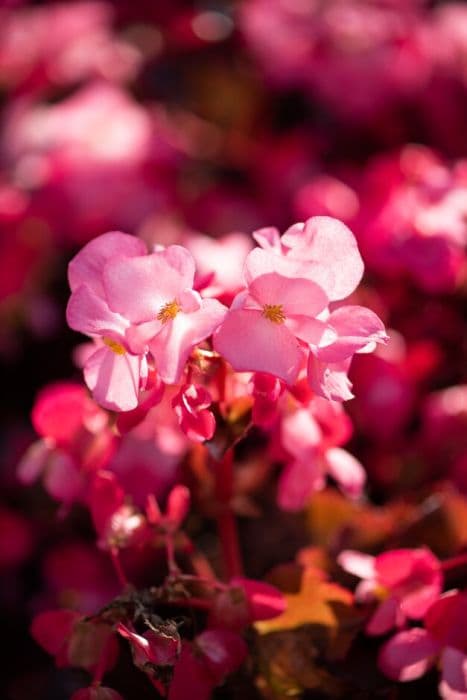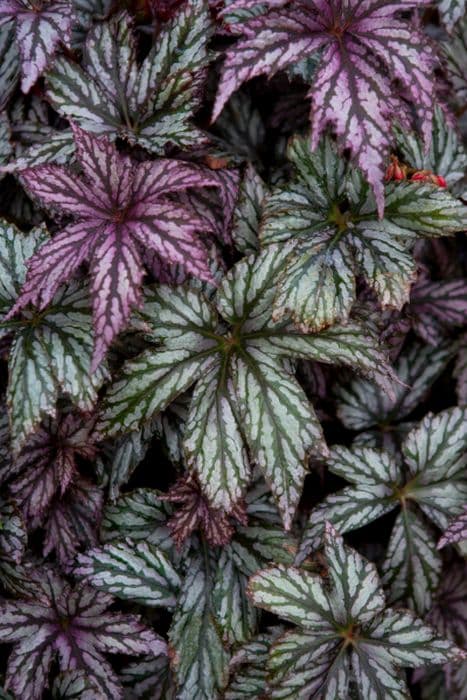Sizemore's begonia Begonia sizemoreae

ABOUT
Begonia sizemoreae is a distinctive and ornamental plant known for its beautiful foliage and impressive leaves. The leaves are large and heart-shaped with a rich green color and a unique frosted, hairy texture that adds to its allure. The foliage often exhibits decorative patterns with light green to white speckles and veins, creating a stunning contrast against the darker green background. The edges of the leaves are decorated with serrated margins, giving the foliage a somewhat ruffled appearance. During its blooming period, the plant produces clusters of delicate white flowers which further enhance its beauty. The stems of the flowers can be seen rising above the foliage, adding an extra layer of interest to the appearance of the plant. Begonia sizemoreae, with its lush and textured leaves, provides a tropical touch to any garden or indoor plant collection, making it a sought-after plant for its aesthetic appeal.
About this plant
 Names
NamesFamily
Begoniaceae
Synonyms
Sizemore's Begonia
Common names
Begonia sizemoreae.
 Toxicity
ToxicityTo humans
Begonia sizemoreae, commonly known as Sizemore's Begonia, is not widely recognized for being toxic to humans. However, it is always prudent to exercise caution and avoid ingestion, as begonias contain compounds that may cause irritation or an allergic reaction in some individuals. There have not been significant enough studies to confirm its toxicity, but if ingested, some possible symptoms can include irritation of the mouth and throat, nausea, vomiting, and difficulty swallowing.
To pets
For Sizemore's Begonia, while it is not known to be one of the most toxic plants for animals, it can still be harmful if ingested by pets, particularly dogs and cats. Members of the Begonia genus contain insoluble oxalates which, if consumed, can cause oral irritation, drooling, vomiting, and difficulty swallowing in pets. It is advisable to keep this plant out of reach to prevent any potential issues.
 Characteristics
CharacteristicsLife cycle
Perennials
Foliage type
Evergreen
Color of leaves
Green
Flower color
White
Height
1-2 feet [30-60 cm]
Spread
1-2 feet [30-60 cm]
Plant type
Herb
Hardiness zones
10
Native area
Vietnam
Benefits
 General Benefits
General Benefits- Decorative appeal: Begonia sizemoreae has attractive foliage with unique patterns and textures that can add visual interest to a garden or indoor space.
- Shade tolerance: This plant is suitable for shaded areas where many other plants might not thrive, making it a versatile option for landscape design.
- Low maintenance: Begonia sizemoreae generally requires minimal care once established, making it ideal for busy gardeners or those new to plant care.
- Humidity resilience: It can tolerate higher humidity levels, which is beneficial in tropical or moisture-rich environments.
- Drought resistance: Once established, it can withstand periods of dryness, reducing the need for frequent watering.
- Non-toxicity: It is not toxic to pets, making it safe to keep around animals.
 Medical Properties
Medical PropertiesThis plant is not used for medical purposes.
 Air-purifying Qualities
Air-purifying QualitiesThis plant is not specifically known for air purifying qualities.
 Other Uses
Other Uses- The waxy leaves of Begonia sizemoreae can be used for decorative purposes in terrariums, adding a lush, green backdrop to the miniature landscape.
- The plant's unique foliage texture can be used as a natural art medium for leaf casting projects, creating detailed and ornate sculptures.
- Due to its attractive foliage, Begonia sizemoreae can be incorporated into floral arrangements to provide a tropical aesthetic.
- The leaves can be used in educational settings to teach botany, specifically the variety of leaf shapes and textures that exist in the plant kingdom.
- Begonia sizemoreae could serve as inspiration for designers and artists, who might mimic the plant's patterns and veining in their own creations.
- The plant can be cultivated as a part of sustainable landscaping practices that focus on the use of native species and biodiversity.
- Because of its low-light requirements, Begonia sizemoreae is ideal for use in office or residential spaces with limited natural light.
- Those practicing mindfulness and relaxation techniques may enjoy the process of tending to a Begonia sizemoreae as a form of stress relief.
- The plant could be used in photography, providing an exotic and textured backdrop for close-up macro photography.
- Begonia sizemoreae can be a teaching tool for discussions about plant care, propagation, and the importance of maintaining humidity levels for certain plant species.
Interesting Facts
 Feng Shui
Feng ShuiThe Begonia is not used in Feng Shui practice.
 Zodiac Sign Compitability
Zodiac Sign CompitabilityThe Begonia is not used in astrology practice.
 Plant Symbolism
Plant Symbolism- Beware: Begonias are often associated with the symbolism of caution or warning. The name "begonia" is sometimes thought to sound like the French phrase "bégueule," meaning "open mouth," which could reference the open shape of the flower as if to speak a warning.
- Cordiality: In some contexts, begonias might represent friendliness or pleasantness, likely due to their appealing and bright flowers that could be seen as welcoming.
- Happiness: The colorful and varied patterns of the begonia flowers can symbolize joy and happiness, making them a popular choice in gardens or as gifts to spread cheer.
- Individuality: With a wide variety of shapes, colors, and types, begonias can symbolize uniqueness and a celebration of being different or standing out from the crowd.
- Resilience: Due to their ability to grow in a variety of conditions, begonias can symbolize endurance and the ability to thrive through adversity or in difficult circumstances.
 Water
WaterThe Sizemore Begonia should be watered regularly to keep the soil consistently moist but not waterlogged. Typically, watering once a week with about 8-16 ounces of water should suffice, but this can vary depending on the humidity and temperature of the environment. During the active growing season in spring and summer, you may need to water more frequently. It's crucial to reduce watering in the winter months when the plant is dormant. Always use your finger to check the top inch of soil for dryness and water thoroughly if it feels dry.
 Light
LightSizemore Begonia flourishes in bright, indirect light conditions. It should be placed in a spot that receives filtered sunlight, away from direct rays that can scorch the leaves. An east or west-facing window with a sheer curtain would be ideal to provide the necessary light without overexposure.
 Temperature
TemperatureSizemore Begonia prefers temperatures between 60 and 80 degrees Fahrenheit. It can survive minimum temperatures of 50 degrees Fahrenheit but should not be exposed to cold drafts or temperatures below this. Ideal growth occurs when the plant is kept in an environment within the preferred temperature range throughout the year.
 Pruning
PruningSizemore Begonia benefits from occasional pruning to remove any dead or yellowing leaves and to promote a bushier growth habit. Pruning should be done in the spring or early summer, using clean, sharp scissors or pruning shears. Make cuts just above a leaf node to encourage new growth, and remove any spent flowers to improve the plant's appearance and redirect energy to new growth.
 Cleaning
CleaningAs needed
 Soil
SoilBegonia sizemoreae, commonly known as Sizemore's Begonia, thrives in a well-draining, airy soil mix composed of peat moss, perlite, and pine bark in equal parts, with a slightly acidic pH of 5.5 to 6.5.
 Repotting
RepottingSizemore's Begonia should be repotted every two years or when it becomes root-bound to ensure continued health and growth.
 Humidity & Misting
Humidity & MistingSizemore's Begonia prefers high humidity levels, ideally between 60% to 70%, to mimic its native tropical environment.
 Suitable locations
Suitable locationsIndoor
Place Sizemore's Begonia in bright, indirect light with high humidity.
Outdoor
Shelter Sizemore's Begonia from direct sun; keep in humid, warm conditions.
Hardiness zone
10-11 USDA
 Life cycle
Life cycleBegonia sizemoreae begins its life as a seed, which once sown in moist, well-draining soil and exposed to warm temperatures, will germinate. Following germination, seedlings emerge, developing into juvenile plants that produce a rosette of distinctive hairy, heart-shaped leaves. As they mature, the plants form rhizomes, which allow them to spread and produce more foliage. Once the plant reaches maturity, it blooms, displaying small white flowers with yellow centers, typically in spring or summer. After pollination, if successful, flowers give way to winged seed capsules containing tiny seeds that can be dispersed by wind or water. The plant then enters a period of dormancy, usually in the cooler autumn and winter months, only to rejuvenate and grow again with the return of favorable conditions.
 Propogation
PropogationPropogation time
Spring to Summer
Begonia sizemoreae, a beautiful shade-loving plant known for its distinctive foliage, is typically propagated by leaf cuttings, and the most popular method is through the division of rhizomes, especially during the spring or early summer when the plant is actively growing. To propagate by rhizome division, the plant should be carefully lifted from its pot, and using a clean, sharp knife, the rhizome should be cut into sections ensuring that each section has at least one growth point or bud. The rhizome sections can then be potted in a well-draining soil mix, ideally with a high percentage of peat and perlite which helps retain moisture while also facilitating drainage. The new pots should be kept in a warm, humid environment but out of direct sunlight until the new Begonias are well-established. After a few weeks, the cuttings will develop roots, and new growth will begin to appear, signaling successful propagation.





![Begonia [Devotion]](/_next/image?url=https%3A%2F%2Fplants-admin.emdemapps.com%2Fimages%2Fplants%2F%2Fimages%2F604b58183573b.png&w=640&q=75)



